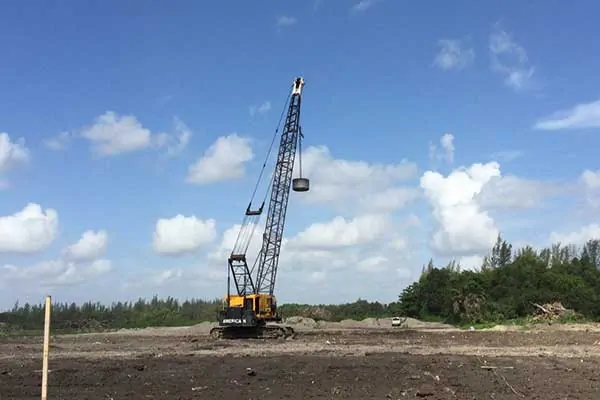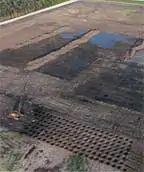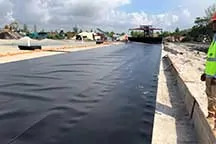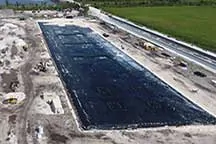


As large tracts of geographically desirable vacant land become scarcer, residential and commercial property developers are increasingly turning to old landfills or former dumps. However, such redevelopment is complex and rife with uncertainties. When compared to greenfield development, the land acquisition costs are lower. Still, any savings are typically offset by greater environmental and infrastructure costs associated with the foundation, landfill gas management, stormwater management, groundwater impacts, meeting closure requirements, and multiple regulatory agency coordination. Therefore, it is important to maximize the developable area while providing engineering solutions to make the project economically feasible. In this blog, we identify some options to reuse challenging sites and lessons learned to contribute to successful redevelopment projects.

Deep Dynamic Compaction
Old landfills or dumps present some unique soil stability challenges. Deep dynamic compaction (DDC) is a ground stabilization technique that has gained popularity in recent years to improve subsurface soil conditions. DDC involves dropping 6 to 30-ton weights from a height between 30 and 75 feet to achieve the desired soil compaction. DDC can effectively apply to a range of subsurface materials, including former C&D debris or municipal solid waste dumps.
DDC provides a stable foundation for future development, minimizes differential settlement while leaving the landfill waste in place, and eliminates the costs associated with removing, transporting, and disposing of buried waste, costing millions of dollars. For simplicity’s sake, let’s consider a 1-acre old landfill or a dumpsite with an average of 15 feet of waste. If excavating the waste and replacing it with clean fill, the disposal fee costs for the excavated waste alone could exceed $400,000. Alternatively, DDC costs range from $1.50 to $2.00 per square foot or $65,000 to $87,120 per acre, excluding mobilization, which costs around $30,000.

Gas Mitigation Systems
Constructing buildings on top of dynamically compacted areas generally requires a combustible gas barrier layer below the building foundation to manage subsurface combustible gases (typically methane). The barrier is required because the waste remains in place. In its simplified form, gas mitigation systems include:

These gas mitigation systems can be either a passive or an active system with a blower. The cost of such systems varies depending on the size of the building, location, and type of liner system used. Typical capital costs for passive systems are in the range of $7 to $9 per square foot for the spray-applied liner and $3 to $4 per square foot for the HDPE liner. For an active system using blowers, add $3 to $4 per square foot. The designer configures a system from these options to address the client’s risk preference and considering future tenant preferences.
Using innovative approaches, impaired lands are increasingly attractive to developers. Beyond the cost-saving benefits to developers realized through DDC and an appropriate gas mitigation system, such projects also create local jobs, increase the tax base, and protect public health and the environment.
About the Authors:

The value of land in large metro areas has climbed so high that developers investigate developing sites previously filled with trash, garbage, debris, or used by industry or the military. Redevelopment or rehabilitation of these properties is performed in accordance with approved urban renewal plans, and under site-specific environmental agencies. Some of these sites have regulatory agency files but filed when regulations were not as strict as they are today. Other sites are so old that they have not been on regulatory agency radar.
Due Diligence
Developers usually pay a lower price for such lands compared to a virgin land, which is rare to find in prime commercial or industrial areas, or land that has a dilapidated building on it, only suitable for demolition. Developers know that they are responsible for handling any environmental issues as soon as they open a file with a regulatory agency for the redevelopment of the property. Environmental due diligence helps determine the costs of addressing environmental issues before purchase.
Another essential part of due diligence is examining the foundation – whatever is below the ground surface, to determine its load-bearing properties for future development. There are several options available to improve load-bearing capability depending on the type, depth, and age of the below-surface material and the load-bearing properties required of the proposed development. Developers hire geotechnical engineers, to factor this, and many more parameters into an evaluation of the site, and to develop options for improving foundation strength.
Dynamic Compaction
One option for improving foundation strength is through dynamic compaction, which involves dropping a heavy load from a significant height for a certain number of times on locations identified by a grid pattern. The kinetic energy of the weight at the time of impact on the substandard foundation compresses the material, reduces voids in-between material particles, and increases internal friction or shear strength of the material. The practice has been around for decades, and developers are familiar with the methodology. The design of a dynamic compaction program is best carried out by a geotechnical engineer familiar with site conditions and parameters. Dynamic compaction is a reasonable and cost-effective option for specific vertical development to improve load-bearing foundations.
Installing Piles
Another option is installing piles in a grid pattern into the ground, extending into the virgin ground. The piles carry the building load via pile skin friction or point resistance at the tip of the piles. Driving piles is more expensive than the dynamic compaction option discussed above. Piles are characteristically useful for high design loadings. Dynamic compaction is useful to minimize ground settlement around the piles, preventing voids from forming below the building as the ground settles over time. While the building remains at its constructed elevation above piles, dynamic compaction helps avoid problems with utilities below the building slab, including water lines, sewer lines, and electrical lines. Limiting the amount of settlement prevents future vertical shifts in ingress and egress structures, driveways connected to the building, docking ports for trailers, and outside staircases if not located on piles.
The gas vapor barrier system under the building prevents unwanted gas from moving upward from materials in the ground into the building. Minimizing settlement by performing dynamic compaction prevents the barrier from vertically shifting and opening passages for unwanted gas moving into the building. The integrity of the barrier layer is essential in maintaining the building’s protection. These problems are tremendously expensive to fix, and agency officials could deem the structure unsafe for occupation.
Excavation
A third option is the excavation of unsuitable material then backfilling with suitable soil. Depending on the contamination, it is possible to clean the soil then return it clean as backfill. For the building foundation to have sufficient bearing capacity, a geotechnical engineer oversees the operation. Filling the excavation in dry conditions is less complicated than wet conditions. In sites where excavation is deep and groundwater is high, dynamic compaction of the backfill, placed in the ground in wet conditions, may be necessary to achieve sufficient shear strength to support the proposed development.
Developers and city planners want viable solutions that are financially reasonable. While dynamic compaction may sound like a crude methodology, it plays a vital role in improving substandard foundations. If you are considering redevelopment of a landfill, Brownfield or other property where the foundation is currently unsuitable consider establishing a business relationship now with a reliable dynamic compaction contractor since they are highly in demand and their availability can affect the project schedule.
About the Author: Ali Khatami, Ph.D., PE, LEP, CGC, is a Project Director and a Vice President of SCS Engineers. He is also our National Expert for Elevated Temperature Landfills, plus Landfill Design and Construction Quality Assurance. He has nearly 40 years of research and professional experience in mechanical, structural, and civil engineering.
Dr. Khatami has many followers of his blog series “SCS Advice from the Field” on SCS’s website and social media channels. Send him a question or topic you’d like him to address.
by Ali Khatami, Ph.D., P.E., SCS Engineers
In south Florida, rising prices of vacant land and unavailability of large parcels of virgin land for development have forced land developers to look into developing old and newly filled lakes. The land price for these lakes is significantly lower than the virgin land and deals are arranged to incorporate the cost of improving the lakefill land into a developable land in the purchase price. Aside from environmental issues that are handled by environmental engineers in relation to obtaining development permits, the ground itself must be improved to sustain the stability needed to bear the proposed development load. Deep Dynamic Compaction (DDC) is proven to be the most economical option for low rise and lightweight developments, such as commercial or industrial warehouses.
The model developed for the Federal Highway Administration (FHWA) report entitled “Dynamic Compaction, Geotechnical Engineering Circular No. 1”, by Robert G. Lukas, dated March 1995, is the primary basis of most DDC programs. Experience of the engineer with the type of the material below the surface is important because the type of material plays an important role in selecting the DDC design parameters used in the model. The design methodology considers four categories of materials in pervious grained soil, semi-pervious soil, partially saturated impermeable deposits, and landfills. The fourth category, landfills, covers waste materials in old landfills but also the material used to fill lakes to create land for new development at a later date.
The material going into a lake may vary depending on the age of the fill placed in the lake. Older lakes filled with debris may include materials that today would never be allowed; while newer lakes are in accordance with state or local regulatory agency environmental permits, which follow a monitoring protocol during filling. The debris in newer lakes may consist of concrete debris, soils, tiles, and any other types of materials classified as clean debris in accordance with the material definitions in the rules.
There are three primary parties involved in this type of brownfields work including the developer, the banker, and the future buyer. Each party has a learning curve to understand and protect their interests.
Developers are cautious because they, very rightfully, have reservations regarding the effectiveness of DDC on the planned investment. Engineers will need several one-on-one and one-on-group teaching sessions with the developer’s primary engineer in charge of the project, and gradually meeting with the engineer’s boss, project director, and eventually the executives of the developing firm. Past successful experience with similar projects play a very important role in justifying the DDC methodology; engineers need to have accurate data and unit costs in tabulated form as part of their arsenal for convincing those in the learning curve.
The process becomes even more complicated when the engineer has designed the DDC program, prepared plans and specification for implementation of the program and the project goes to bid by DDC contractors. To win the work, it is typical for each DDC contractor in the bidding process to return to the client with their version of a DDC program and sometimes less expensive one to put themselves ahead of others. The alternative plans will propose using different equipment, usually the specific equipment that the bidding party already owns, or modeled under a different set of design parameters than the ones prepared by the engineer. Expect communications to become intense, and even with a now more educated developer, they will question every detail of the original planned design. It can be a frustrating and confusing period for all parties.
The engineer must plan to routinely justify his/her design based on design methodologies in literature, justify the design parameters used in the development of the DDC program, and rely heavily on the past performed projects going back a couple of decades. The engineer should even be prepared to obtain permission from past project owners to show the integrity of the building slabs after being in service for many years.
The DDC designer may also need to obtain design parameters from the DDC contractor who has come up with an alternative design to analyze their design and determine any shortcomings in it. If found, further discussions ensue to reexamine the design at hand as the most reliable and the most effective for the developer. Innovation is wonderful, but an expert engineer will not risk the developer’s investment and reputation using unproven technologies; proven technologies are already part of a reputable engineer’s DDC design.
The best way for inexperienced developers to go through the design and implementation phases of such projects is to find an experienced firm with a significant number of similar projects in its experience and trust the outcome of the work by that design firm. Otherwise, the developer will have a very difficult time sorting out the complexities and questions that alternative designs bring forward. The claims of less expensive scenarios without long-term performance justification as to how the foundation will behave over the long term are too risky. The combination of dealing with a new concept for which the developer has no experience and justifying the financial aspects of a properly designed DDC program can make a project even more difficult for an inexperienced developer.
A developer’s project manager should plan to spend significant time with the DDC designer to become familiar with the DDC concept, construction nuances, and the financial aspects of the project. The project manager will need to visit past projects performed by the designer’s firm to confirm claims by the design engineer. Only at that point, the developer’s project manager should proceed with convincing his/her superiors of the validity of the DDC program while asking for assistance from the DDC designer.
Ali Khatami, Ph.D., P.E., is a Vice President with SCS Engineers. He may be reached at
Additional resources are available on these pages: Brownfields and Voluntary Remediation and Environmental Due Diligence and All Appropriate Inquiries.
Dynamic compaction is a construction technique that increases the density of soil/waste deposits by dropping a heavy weight at regular intervals to consolidate and improve the geotechnical characteristics of the deposit so that it can be suitable for redevelopment. This construction technique can be used to transform otherwise undevelopable property, such as old landfill areas, into developable property.
Most soil types can be improved by dynamic compaction; the method is particularly well suited to non-organic, irregular fill, where variable characteristics such as solid wastes are present. Field conditions and several other parameters are considered when designing and implementing dynamic compaction programs to keep costs in line. The primary considerations include, but are not limited to, waste delineation, distance from the ground surface to ground water, waste thickness, minimum energy, and selection of dynamic compaction parameters.
The following factors and associated costs should be evaluated if dynamic compaction is to be considered:
Major change orders and environmental impacts can be expected if the plan does not address these factors.
If you decide to consider dynamic compaction in your redevelopment project, having onsite construction quality assurance monitoring during the process is important. CQA monitoring will verify that the work is implemented as designed and permitted, and that proper techniques are used to make sure the proper distribution of energy into the ground is taking place. The CQA monitor will also check to see that the final configuration of the fill is achieved, a safe working environment is maintained., and that ground vibrations are monitored near adjacent structures to to prevent structural damage.
For developments involving construction of buildings over a dynamically compacted areas, a combustible gas barrier layer is generally required below the building footprint to safely collect and vent subsurface combustible gases (i.e., typically methane) to the environment. Construction costs associated with a combustible gas barrier layer should include the following:
In summary, dynamic compaction is a proven geotechnical construction engineering method that can be used to improve certain landfill areas to support redevelopment. SCS Engineers has completed many projects of this nature and is ready to serve and help to bring your project in service.
Related Article
Pursuing Dynamic Compaction, by Ali Khatami, Ph.D., Bruce Clark, P.E., and Myles Clewner, L.E.P., Waste Age
Sample Case Studies
Environmental Due Diligence – Procacci Site, Sweetwater, Florida
Landfill Engineering and Consulting – Medley Landfill, Miami-Dade County, Florida
Landfill Site Redevelopment for the City of Industry, California
Ali Khatami, PhD, PE, LEP, CGC, is a Project Director and a Vice President of SCS Engineers. He is also our National Expert for Landfill Design and Construction Quality Assurance. He has nearly 40 years of research and professional experience in mechanical, structural, and civil engineering.
Dr. Khatami has acquired extensive experience and knowledge in the areas of geology, hydrogeology, hydrology, hydraulics, construction methods, material science, construction quality assurance (CQA), and stability of earth systems. Dr. Khatami has applied this experience in the siting of numerous landfills and the remediation of hazardous waste contaminated sites.
Dr. Khatami has been involved in the design and permitting of civil/environmental projects such as surface water management systems, drainage structures, municipal solid waste landfills, hazardous solid waste landfills, low-level radioactive waste landfills, leachate and wastewater conveyance and treatment systems. He has also been involved with the design of gas management systems, hazardous waste impoundments, storage tank systems, waste tire processing facilities, composting facilities, material recovery facilities, landfill gas collection and disposal systems, leachate evaporator systems, and liquid impoundment floating covers.